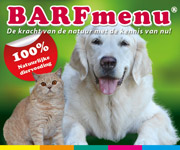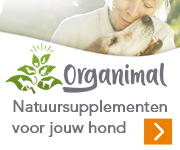Proberen kan geen kwaad...
Dit schrijft Mogens Eliasen over vlooien:
Fleas
The common dog fleas are actually cat fleas. They cannot survive on humans, but they will occasionally try to bite also members of your family. Some people are very attractive to the dog/cat fleas and can be just as plagued by them as the dog.
You get fleas no matter how much you try to clean your home - or keep it clean. There is no correlation between hygiene and getting fleas.
In sharp contrast to almost all other parasites, fleas do not live on the dog. They only eat on the dog - and use the dog for transportation to new places. You can get fleas by simply walking your dog past a bush where the beasts sit and wait for the next dog to come by and give them a ride to a new "home".
They spend 22-23 hours a day off the dog, and they lay their eggs off the dog. This makes them difficult to defeat, because you cannot kill more than 2-5% of them by bathing the dog in flea shampoo...
You do not need to actually see any fleas in order to know for sure that you have them. They leave their poop in the dog's coat. It looks like small drops of cigarette ash, but in contrast to cigarette ash, it gets red when you smear it with a wet finger in your palm.
The real problem with fleas is that they lay their eggs in dark spots, often along the end of a rug, along the cracks between the floor and the walls, between the mattresses in the double bed, and other similar places that are warm, moist, and dark. It takes 2-12 days for them to hatch. The larvae live on dust and organic matter in the environment they were hatched in. They do not go on the dog. They go through another two life stages before they cocoon and become adult fleas. The whole process takes about 3-4 weeks, from egg to adult flea that will now attack the dog to get the blood they need in order to lay eggs.
Prevention is the best cure. But if you got an infestation, you will need to deal with it. For the wolves in nature, if would never really become a problem, because they travel so much. But your dog is destined to stay in the same home every day - so re-infestation is impossible to avoid if you do not do something about it.
I have successfully fought the problem once by simply checking my dogs' coat 5 times daily and manually catching and killing those beasts, systematically, for a period of 3 weeks, using a flea comb. By using the flea comb systematically, you can confine the beasts to the remaining parts of the dog's body - which makes the catching possible. You will quickly learn how to use this tool effectively, as you will have to allow yourself some cursing when you catch one and got it off the skin with the comb, but failed to kill it before it jumped! It is tedious, though, but absolutely possible.... And it is completely safe.
You can help yourself significantly by also applying this very effective, safe old remedy. I got the description of this smart way of doing it from Louise at
www.raw-connections.com - with her permission to pass it on:
Old effective way to control fleas
I ran across this when I was looking for a non chemical way to control fleas. I went to the agriculture department and check their files before 1946 to get this one. I suggested it to Judy B. who had tried lots of other methods and spent a lot of money but found this to be the most effective ;o)))
Try the safe soapy water and light bulb flee controller. Hang light bulb 1 foot above a low container (about a foot wide and 2-3 inches deep and with at least 1 inch of soapy water in it.
It is moved around about 5 feet a day. Alternatively, of them set up. Best places indoors is within 5 feet of where your pet sleeps and you sleep.
The fleas jump to the light (heat) and fall in the soapy water that traps them, and they drown.
You should set up some traps also outdoors.
Remember that fleas are not found in your driveway gravel or in the open. The larvae do not survive high temperatures. They are found in shaded areas, like under porches, decks, car ports, at the edges of woods, and especially in places where your pets lay down outdoors.
It was suggested on one of my lists you put it in a wire crate to keep the other animals out of it.
Works very well

)))
Louise
Well, Louise....after spending hundreds of dollars on natural flea products....the soapy water and light bulb are working like a dream!!!!!!
Thank you, thank you, thank you.

Regards,
Judy B
I had great luck with this the one time I rescued an old beagle lady. She spent the night in one spot at the top of my steps. Next morning I discovered she was covered with fleas. Used the bowl in my office, down the hall from where she slept.
Day 1: 25 fleas. Day 2: 10. Days 3, 4, & 5: 2-3 per day. Then all were gone.
Christina C
I must confess that I have not tested this method myself - I have not had fleas since 1988... If you need to use the method, then I would suggest one simple improvement: Use a colored light bulb instead of a regular white bulb. Fleas do not like bright light, so the light will somewhat reduce their attraction to the heat. But by coloring the light bulb (red is best), you can make the method even better.
But why not use what the chemicals the vet recommends?
Let me just say this: You cannot buy anything that is safe and effective! ALL of the modern "flea prevention products" on the market in North America nowadays work by making the dog poisonous! The remedies that go into the food are the worst. But even those that are applied on the skin get absorbed into the blood and generally make the dog's blood poisonous. That's what kills the fleas. But your dog pays a very heavy price with its health for your convenience, as the side effects of those products are profound and serious - they are all forbidden to use on people...
The only exception is the old, old remedy NEGUVON that was manufactured by Bayer in Germany since the early fifties. It has been proven effective and safe through several decades, but its patent is long run out, so there is no more money in trying to sell it. I have asked Bayer why they do not make it available also in North America, and the answer was that it would be too expensive to obtain the government permit for it when you cannot protect your market through a patent. It would cost the importer about $200,000 to get the import permit for Canada, and about $600,000 for the USA - and those permits would generally be a permit also for all the competitors, as it would approve of the product.... With no patent protection possible, paying this money would be outright stupid, from a business perspective.
However, if you can get your hands on NEGUVON (I always get some when I visit Europe or have friends from Europe visit me), you can use it. It is extremely effective - and is approved in Europe for the use also on udders of cattle used for dairy production for human foods! The reason is that it decomposes completely to harmless chemicals when it gets exposed to oxygen after having been wetted.
This is a bit of a curse, though, when using it on a dog: you dissolve the NEGUCON in water and soak the dog's coat with this water. No rinsing! No drying - other than natural or with an electrical hair drier. This will leave a thin film of the stuff on the all the hairs - and when the fleas touch it as intensively as they will do when crawling around in that coat, it will kill them in a matter of hours.
Now, this takes care of those that are on the dog - and those that will jump on the dog for the next few days. But the effect wears off in 10-12 days, as the NEGUVON decomposes. So, after 10 days, you apply another soaking with some fresh NEGUVON. And then another one 10 days later, just to be sure that you catch all the hatchlings also that were started as eggs when you started the treatment.






